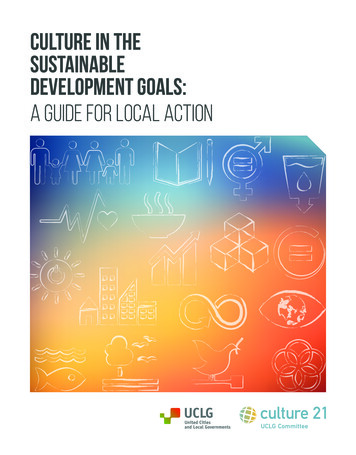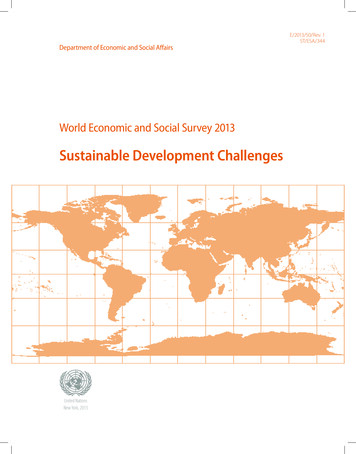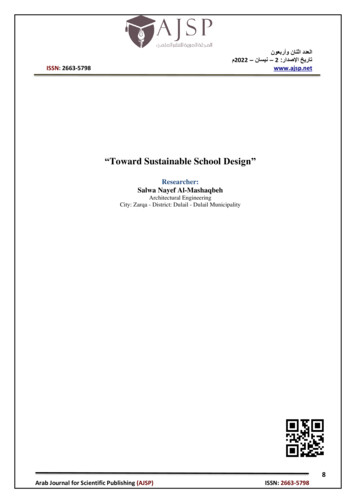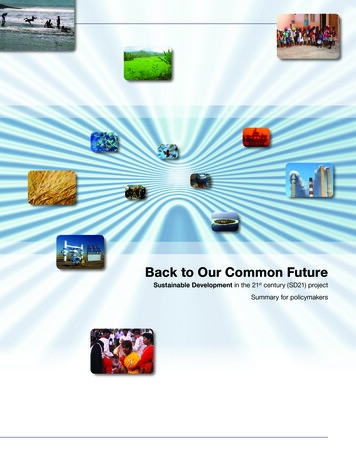
Transcription
CULTURE IN THESUSTAINABLEDEVELOPMENT GOALS:A GUIDE FOR LOCAL ACTION
May 2018.United Cities and Local Governments (UCLG) represents and defends the interests of local governments on the world stage, regardlessof the size of the communities they serve. Headquartered in Barcelona, the organisation’s stated mission is to be the united voice andworld advocate of democratic local self-government, promoting its values, objectives and interests, through cooperation between localgovernments, and within the wider international community.The Committee on Culture of UCLG is the platform of cities, organizations and networks that foster the relation between local culturalpolicies and sustainable development. It uses the Agenda 21 for culture as its founding document. It promotes the exchange ofexperiences and improves mutual learning. It conveys the messages of cities and local governments on global cultural issues. TheCommittee on Culture is co-chaired by Buenos Aires and Mexico City, and vice-chaired by Angers, Barcelona, Belo Horizonte, Bilbao,Bogotá, Jeju, Paris and Porto Alegre.This guide was written in the framework of the implementation of the Agenda 21 for culture and Culture 21 Actions, and it contributes tothe activities of the Global Taskforce of Local and Regional Governments.Following a draft version circulated in mid2017 and a consultation period thereafter, this final version of the guide is published in May2018. UCLG wishes to express a sincere gratitude to all those who have participated in this process.
CULTURE IN THESUSTAINABLEDEVELOPMENT GOALS:A GUIDE FOR LOCAL ACTIONAdopted by the General Assembly of the United Nations in September 2015, Transforming Our World:the 2030 Agenda for Sustainable Development is the global agenda on sustainable development until2030. Building on the Millennium Development Goals (MDGs), the global agenda that was pursuedfrom 2000 to 2015, the new 2030 Agenda includes 17 Sustainable Development Goals (SDGs) and169 specific targets. This is, indeed, a global agenda, the aims and themes of which should betaken into account in all world regions, countries and cities.The 2030 Agenda amounts to a minor step forward in the consideration of cultural aspects in sustainable development. In the years leading to the adoption of the SDGs, several global networkscampaigned, under the banner ‘The Future We Want Includes Culture’, for the inclusion of onespecific goal devoted to culture, or for the integration of cultural aspects across the SDGs. Fourdocuments, including a manifesto, a declaration on the inclusion of culture in the 2030 Agenda, aproposal of possible indicators for measuring the cultural aspects of the SDGs, and an assessment ofthe final 2030 Agenda, were produced between 2013 and 2015. The Committee on Culture of UCLGwas one of the lead networks of the campaign.Although none of the 17 SDGs focuses exclusively on culture, the resulting Agenda includes severalexplicit references to cultural aspects. The following elements are particularly worth noting: Target 4.7 refers to the aim to ensuring that all learners acquire the knowledge and skills needed to promote sustainable development, including, among others, through education for globalcitizenship and the appreciation of cultural diversity and of culture’s contribution to sustainabledevelopment. Target 8.3 addresses the promotion of development-oriented policies that support productiveactivities as well as, among others, creativity and innovation. Targets 8.9 and 12.b refer to the need to devise and implement policies to promote sustainable tourism, including through local culture and products, and to the need to develop suitablemonitoring tools in this area. Target 11.4 highlights the need to strengthen efforts to protect and safeguard the world’s cultural and natural heritage.
Furthermore, as this document will aim to demonstrate, cultural aspects will play a pivotal rolefor the overall 2030 Agenda to be successful, including in areas where connections may only beimplicit. In practice, as evidence collected over the years has amply demonstrated, cultural aspects,including active participation in cultural life, the development of individual and collective culturalliberties, the safeguarding of tangible and intangible cultural heritages, and the protection andpromotion of diverse cultural expressions, are core components of human and sustainable development. They can also have positive effects in other areas of sustainable development. As thePreamble of the 2030 Agenda indicates:“We acknowledge the natural and cultural diversity of the world and recognize that all cultures andcivilizations can contribute to, and are crucial enablers of, sustainable development.”Cultural aspects play a pivotal role for the 2030 Agendato be successful. Cultural rights, heritage, diversity andcreativity are core components of human and sustainabledevelopment.For more than a decade, United Cities and Local Governments (UCLG) has been an active advocateof the integration of culture in all approaches to sustainable development. The Agenda 21 forculture, adopted in 2004, has become a key reference for local governments, civil society activistsand experts committed to the integration of culture in local sustainable development. This wasfurther strengthened in 2015 with Culture 21: Actions, a practical toolkit that outlines 100 actionsthrough which culture contributes to making cities more sustainable. A Policy Statement adoptedby the 3rd World Congress of UCLG in 2010 also recognizes culture as the fourth pillar of sustainabledevelopment and calls on cities and local and regional governments around the world to develop asolid cultural policy and to include a cultural dimension in all public policies.As UCLG has also explained, all of the SDGs have targets that are directly or indirectly related to thedaily work of local and regional governments. The 2030 Agenda devotes Goal 11 to ‘Make Cities andHuman Settlements Inclusive, Safe, Resilient and Sustainable’, thus marking a major step forwardin the recognition of the transformative power of urbanization for development. Yet all SDGs shouldbe ‘localized’ – localizing development means taking into account subnational contexts in theachievement of the 2030 Agenda, from the setting of goals and targets, to determining the meansof implementation and using indicators to measure and monitoring progress. It is also puttingthe territories and the people’s priorities, needs and resources at the centre of sustainable development. The Localizing the SDGs portal developed by the Global Taskforce of Local and RegionalGovernments, UN-Habitat and the United Nations Development Programme and the practical guideThe Sustainable Development Goals: What Local Governments Need to Know provide excellent startingpoints to understand and put into practice the localization of sustainable development.At the crossroads of sustainable development, culture and cities, this publication aims to providepractical guidance to local and regional governments, civil society organisations, private organisations, culture and development professionals, and other stakeholders interested in strengtheningpartnerships, policies, projects and practices around the place of culture in the achievement of theSDGs. The document builds on the work of the UCLG Committee on Culture, as well as on many relevant policies, programmes and projects implemented by cities around the world, and contributionsmade by several other organisations, networks, communities and individuals that have addressedand demonstrated the cultural dimension of sustainable development.
DOCUMENT STRUCTUREThe following section is structured on the basis of the 17 SDGs that make up Transforming OurWorld: the 2030 Agenda for Sustainable Development adopted in 2015. Under each Goal, the document presents information that helps to understand why culture is relevant, and how this connection can be made effective at local level. In particular, the following sections will be found: An initial summary of the key themes addressed by each Goal, based on the text of TransformingOur World. A section entitled How is culture relevant?, describing why cultural aspects are significant forthe achievement of the relevant role. This section takes into account the explicit references toculture made in the 2030 Agenda, but also builds on evidence existing elsewhere. Under What can cities do?, recommendations aimed at cities and local governments to explorethe links between culture and other policies, programmes and practices related to the achievement of the relevant role are presented. This draws on some previous documents and policyguidelines, as well as on observations made in cities around the world. Finally, How cities make this effective – some examples presents evidence from cities whichhave proven the importance of culture to achieve the relevant Goal. Examples have been collected via UCLG’s existing policy monitoring tools (including the Agenda 21 for culture’s good practice database) as well as from other sources, and also include contributions made by experts andpartners. UCLG is aware that the set of examples presented in this document is non-exhaustiveand will continue to collect relevant practices addressing culture and sustainable development.
GOAL 01How is culture relevant?Cultural services are basic services and equal access tothem should be guaranteed for all men and women,including the poor and the vulnerable.Cultural expressions, services, goods and heritage sitescan contribute to inclusive and sustainable economicdevelopment.What can cities do?END POVERTY IN ALL ITSFORMS EVERYWHEREThis goal calls for an end to poverty in all itsmanifestations by 2030. It also aims to ensuresocial protection for the poor and vulnerable,increase access to basic services and supportpeople harmed by climate-related extremeevents and other economic, socialand environmental shocks and disasters.Ensure that minimum service standards for basiccultural services exist (for example, a minimum numberof libraries or books per inhabitant, and the adoptionof programmes fostering decentralisation of culturalservices), so that everyone has access to culture.Integrate cultural aspects, and the preservation ofcultural resources and capacities, in local economic andresilience strategies, which should also engage localcommunities.How cities make this effective- some examplesIn Pekalongan, which recognizes itself as the ‘Cityof Batik’, local strategies giving priority to thistraditional textile sector have contributed to generatingemployment. Batik is the main economic sector in thecity and 60% of the employees in the sector are women.In Porto Alegre, the local government has adoptedpolicies and programmes to decentralise opportunitiesto access culture, making citizens’ cultural rightseffective and strengthening collaboration with NGOs andcommunity groups.In Ouagadougou, the Reemdoogo Music Garden, a culturalinfrastructure that provides training, performance andrecording facilities, has broadened opportunities foryoung people and contributed to the emergence ofseveral small businesses.The cultural policies of Lille-Métropole have contributedto increasing access to culture for everyone, through theenhancement of cultural infrastructure at neighbourhoodlevel, the development of cultural educationopportunities and the promotion of specific programmesfor disadvantaged groups.
GOAL 02END HUNGER, ACHIEVE FOODSECURITY AND IMPROVEDNUTRITION AND PROMOTESUSTAINABLE AGRICULTUREThis goal aims to end hunger and all formsof malnutrition by 2030. It also commitsto universal access to safe, nutritious andsufficient food at all times of the year. Thiswill require sustainable food productionsystems and resilient agricultural practices,equal access to land, technology and markets,and international cooperation on investmentsin infrastructure and technology to boostagricultural productivity.Target 2.5 refers to the need to maintain thegenetic diversity of seeds, cultivated plants andfarmed and domesticated animals and their relatedwild species, including through the utilizationof traditional knowledge associated with geneticresources.How is culture relevant?Traditional knowledge related to the preservation ofexisting genetic resources, including the genetic diversityof seeds, should be recognized and maintained, and thefair sharing of the relevant benefits should be promoted.What can cities do?Integrate cultural factors, including the knowledge,traditions and practices of all people and communities,into local strategies on environmental sustainability.Establish programmes to preserve and spread traditionalknowledge and practices that contribute to thesustainable use of natural resources.How cities make this effective- some examplesIn Seferihisar, the Seed Swap Festival has enabled localproducers to maintain traditional, low-cost agriculturalpractices and raised awareness of the need to preservesustainable food production and consumption.
GOAL 03How is culture relevant?Health policies and programmes need to be culturallyrelevant, taking into account local customs, as well asintegrating traditional health systems and practitionerswhere appropriate.Participation in cultural life can contribute to improvedhealth and well-being, as recognised by an increasingnumber of studies and examples.What can cities do?ENSURE HEALTHY LIVES ANDPROMOTE WELL-BEING FORALL AT ALL AGESThis goal seeks to ensure health and wellbeing for all, at every stage of life. TheGoal addresses all major health priorities,including reproductive, maternal and childhealth; communicable, non-communicableand environmental diseases; universalhealth coverage; and access for all to safe,effective, quality and affordable medicinesand vaccines. It also calls for more researchand development, increased health financing,and strengthened capacity of all countries inhealth risk reduction and management.Include explicit references to cultural factors in localpolicies in the areas of health and well-being.Regularly analyse the relationship existing betweenpersonal welfare, health and active cultural practicesat local level.Ensure that capacity-building programmes are availableto enable health and social service professionals toidentify and tackle the cultural factors that preventpeople from accessing these services.Provide support to programmes and projects that fosteraccess to and participation in culture within healthsettings (hospitals, health centres, etc.).How cities make this effective- some examplesIn Vaudreuil-Dorion, the “Je suis ” culturalengagement project involves a wide-range set of localactors, including health centres, and has generatedpositive results in areas including perinatal health andmental health.A range of strategic documents adopted by Malmö,including the Action Plan for the Culture Strategy 20162018, identify health as a key factor in local sustainabledevelopment and plan to increase access to culture inhealthcare, social care and support activities.Located in a disadvantaged neighbourhood ofMontevideo, the Sacude Civic Centre has broadenedaccess to health, culture and sports for local citizens,involved them in priority-setting and management,and contributed to the integration of a culturaldimension in local healthcare programmes.
GOAL 04Target 4.7 aims to ensure that all learners acquirethe knowledge and skills needed to promotesustainable development, including, among others,through education for sustainable developmentand sustainable lifestyles, human rights, genderequality, promotion of a culture of peace and nonviolence, global citizenship and appreciation ofcultural diversity and of culture’s contribution tosustainable development.How is culture relevant?ENSURE INCLUSIVE ANDEQUITABLE QUALITYEDUCATION AND PROMOTELIFELONG LEARNINGOPPORTUNITIES FOR ALLThis Goal aims to ensure that all girls andboys have access to quality early childhooddevelopment and can complete free, equitableand quality primary and secondary education.It also aims to ensure that equal access forall women and men is available to tertiaryeducation, and that the number of youth andadults who have relevant skills for employmentincreases. Other aspects addressed include theelimination of gender disparities in educationand an increase in the achievement of literacyand numeracy among all youthand a substantial proportion of adults.Educational programmes at all levels need to integratecontents related to cultural diversity, arts education,languages, and the role of cultural aspects in sustainabledevelopment.A cultural approach, including recognition of locallanguages and locally-relevant abilities, and theinvolvement of cultural stakeholders, needs to prevailin the design of curricula at all levels – this is in linewith human rights, and can contribute to educationalobjectives, including students’ motivation andcommunity connections.What can cities do?Adopt a local strategy linking educational policy andcultural policy.Work to ensure that the curricula in primary andsecondary education include the acquisition of culturalskills and knowledge, intercultural dialogue, diversity,tangible and intangible heritage, and cultural rights.Provide educational activities for formal and informalenvironments within cultural facilities (e.g. culturalcentres, museums, libraries, theatres, etc.), sites(heritage buildings, archaeological sites, etc.) andprogrammes (festivals, cultural initiatives, etc.).Foster the involvement of artists and culturalprofessionals in education, training and other learningcontexts, in order to foster access to and participationin cultural life for citizens of all ages.Recognise the important role of libraries in fosteringinclusive and equitable education and lifelong learning,through their support of literacy programmes, provisionof safe spaces for learning, etc.
How cities make this effective- some examplesIn Barcelona, the “Creators in Residence” project hasenabled secondary schools to develop partnerships withartists and creative groups in a range of art disciplines,involving students in creative processes and fosteringaccess to culture for all.The Arena da Cultura – Open School for the Arts in BeloHorizonte, has provided access to quality arts educationin a wide range of disciplines for thousands of citizensand has paved the way for new professional careers inthe cultural field.In Bogotá, a range of initiatives have contributed toenabling access to culture for tens of thousands ofchildren and young people through school and out-ofschool activities, with positive social and educationalresults.Under the banner L’Art pour grandir (‘Arts to grow up’),the City of Paris provides a wide range of opportunitiesto access arts opportunities in schools, libraries, cinemas,conservatories, museums and other cultural venues,aimed at children and young people.In the context of its Traditional Culture City project,Jeonju has integrated an appreciation of traditionalculture in education and lifelong learning programmes,helping children and adults to understand the importanceof traditional buildings, intangible heritage and othercultural assets.Experiences of several cities that have integrated anintercultural approach in their educational policies andprogrammes, including Cascais, Getxo, Haifa, Limassol,Neuchâtel, Patras, Portimão, Reykjavik and Donostia/San Sebastian, have been promoted in the context ofthe Council of Europe’s Intercultural Cities programme.
GOAL 05ACHIEVE GENDER EQUALITYAND EMPOWER ALL WOMENAND GIRLSThis Goal aims to end all forms ofdiscrimination against women and girlseverywhere, and eliminate all forms of violenceagainst them, and other harmful practicesagainst women and girls, in the public andprivate spheres. The Goal also aims to ensurewomen’s full and effective participation andequal opportunities for leadership at all levelsof decision-making in political, economic andpublic life. Furthermore, it sets the targetof ensuring universal access to sexual andreproductive health and reproductive rights.UNESCO published the report on genderequality and culture “Gender Equality: Heritageand Creativity” in 2014, in the contextof preparations for the 2030 Agenda. Thedocument responds to the urgency of a deeperdebate, research and awareness on genderequality and the need for equal cultural rights,responsibilities and opportunities for everyperson to develop his or her full potential.The report highlights UNESCO’s approach topromoting gender equality, underpinned bythe international human rights framework. Thereport is based on a commitment to culturalrights and cultural diversity, with emphasison heritage and creativity as enablers forall people, despite the recurring use oftraditions, religions or social norms to justifythe infringement on human rights or theirlimitation, for girls and women specially.Heritage is associated to social valuesdeveloped over time, so heritageidentification, preservation and transmissionare the result of a choice, which is mostoften biased. Gender should be taken intoaccount in order to ensure a plural and diverserepresentation of sites and practices across theworld. As the report shows, the lack of genderawareness demonstrated in safeguardingtangible and intangible cultural heritage at alocal and a global level —for instance, withinthe framework of the lists derived from the1972 World Heritage Convention and the 2003Convention on Intangible Cultural HeritageHeritage— leads to big challenges that haveto be addressed by all local, regional andnational governments and the internationalcommunity.Similarly, high priority should be accordedwithin sustainable development to thesituation of women and girls in the field ofcreativity: this must include the recognitionof the cultural and historical discriminationwomen face in fully engaging in creativeprocesses, across different cultural disciplinessuch as film, theatre or live performance.And along with the stereotypes, stigma andsexism, another invisible barrier for women tobe fought is the lack of gendered information,data and analysis.
As the UN Special Rapporteur in the field ofcultural rights at that time, Farida Shaheed,points out: “It is time for a paradigm shift:from viewing culture as an obstacle to women’srights to one of ensuring women’s equalenjoyment of cultural rights.” And this canonly be achieved when culture is completelyperceived as an inherent component of societywhich permeates all kinds of human relations inlife, including those based on power, whetherthis is visible and acknowledged, or not.How is culture relevant?Gender equality should also be achieved in culturallife: opportunities for women and girls to take activepart in cultural life and lead their own projects andorganisations in this area need to be broadened.Further visibility and recognition needs to be given tocultural practices carried out predominantly by womenand girls.Narratives that address gender discrimination or whichshow the important role of women and girls in culturallife are needed.What can cities do?Integrate a gender dimension in cultural policy and acultural dimension in policies fostering gender equalityand addressing gender discrimination.Take measures to eliminate gender discrimination andall forms of violence and harmful practices againstwomen and girls in cultural activities.Ensure that the voices of women receive equal spaceand profile in the local media.Ensure that cultural programmes and organisationsthat receive public support practice gender equality.How cities make this effective- some examplesIn Ramallah, the decentralisation of cultural policy,which has fostered an understanding of the importanceof culture in local governance and sustainabledevelopment, has paid particular attention to theinvolvement of women and girls in participatoryactivities and in cultural activities.In Rosario, the ‘Workshop’ arts centre provides creativeopportunities to vulnerable groups and has developed arange of programmes enabling women to produce theirown works and narratives.The work of the Women’s Education for Advancementand Empowerment (WEAVE) organisation in Myanmarincludes the provision of safe employment opportunitiesfor women based on traditional craft-making skills.
GOAL 06ENSURE AVAILABILITY ANDSUSTAINABLE MANAGEMENTOF WATER AND SANITATIONFOR ALLThis Goal aims to ensure universal andequitable access to safe and affordabledrinking water, as well as access to adequateand equitable sanitation and hygiene toall, paying special attention to the needsof women and girls and those in vulnerablesituations. The improvement of water quality,the increase in water-use efficiency, and theprotection and restoration of water-relatedecosystems, including mountains, forests,wetlands, rivers, aquifers and lakes, are alsoaddressed.How is culture relevant?Some elements in traditional knowledge can providelessons towards fostering an appropriate, sustainableuse of water-related ecosystems.What can cities do?Explicitly recognise in local cultural policies theconnections between culture and environmentalsustainability, including the sustainable use of resources.Explore the potential of cultural facilities, events andactivities as contexts where to raise awareness ofwater scarcity and sustainable uses of water-relatedecosystems.How cities make this effective- some examplesIn Puno, a city located along the shores of Lake Titicaca,the Hamuy Cocha Festival fosters respect andcompromise for the world’s water resources, includingthe preservation of ecosystems that create rivers,lakes and lagoons.In Val-de-Marne, the H2-OH! Festival aims to regainan area of rivers and creeks, foster respect for naturalresources and common goods, and raise citizens’awareness on the impacts of their behaviour on thepreservation and sustainability of the water ecosystem.The Nile Project is an international initiative involvinguniversities, policy-makers and musicians, among others,that fosters an understanding of the Nile as a sharedecosystem among communities across the 11 countriesthat make up its basin, through, among others, a musicaldialogue.
GOAL 07How is culture relevant?Cultural factors, often inadvertently, underpin energyproduction and consumption patterns.Creative actors can be involved in the design ofeducational and awareness-raising activities on energyproduction and consumption.What can cities do?Explore the potential for creative processes to fosternew approaches to energy production and consumption.ENSURE ACCESS TOAFFORDABLE, RELIABLE,SUSTAINABLE AND MODERNENERGY FOR ALLThis Goal aims to ensure universal accessto affordable, reliable and modern energyservices, substantially increase the share ofrenewable energy in the global energy mix,and double the global rate of improvement inenergy efficiency. International cooperationand upgraded technology are also identifiedas steps servicing this Goal.Ask cultural organisations that receive public supportto evaluate their environmental impact and carryout awareness-raising activities on environmentalsustainability.How cities make this effective- some examplesA report produced by the International Federation ofLibrary Associations and Institutions (IFLA) describeshow libraries in Croydon, Derby and other cities in theUK enable users to borrow energy monitors to find outwhich electrical appliances use a lot of energy, enablingthem to change and reduce their energy use.The Newton Machine is a participatory, artisticintervention developed in Eday, leading to a prototypefor storing energy produced in an environmentallysustainable way.
GOAL 08PROMOTE SUSTAINED,INCLUSIVE ANDSUSTAINABLE ECONOMICGROWTH, FULL ANDPRODUCTIVE EMPLOYMENTAND DECENT WORK FOR ALLThis Goal involves the achievement ofsustained per capita economic growth,with higher levels of economic productivityand development-oriented policiesthat support decent job creation andentrepreneurship. Other issues addressedinclude the achievement of full and productiveemployment and decent job for all women andmen, including for young people and personswith disabilities, equal pay for work of equalvalue, the reduction of the proportion of youthwho are not in employment, education ortraining, the eradication of forced labour andthe protection of labour rights.Target 8.3 refers to the promotion ofdevelopment-oriented policies that supportproductive activities, decent job creation,entrepreneurship, creativity and innovation, andencourage the formalisation and growth of micro-,small- and medium-sized enterprises, includingthrough access to financial services.Meanwhile, Target 8.9 addresses the need to deviseand implement policies to promote sustainabletourism that creates jobs and promotes localculture and products.How is culture relevant?The cultural and creative sectors have the potential tobe areas for inclusive, sustainable and fair employment,insofar as the appropriate labour conditions, inaccordance with international human rights, areguaranteed.Cultural aspects can be integrated in tourismstrategies, while ensuring that this does not implydecontextualisation of cultural identities, activities andassets and that relevant benefits are reinvestedin cultural activities.What can cities do?Explore the potential of the cultural and creativesectors to contribute to inclusive, sustainable and fairemployment.Ensure that the local tourism model is sustainable,balanced across the city or region, connected to thelocal communities and interactive with the culturalecosystems.Include cultural knowledge, skills and jobs inemployability programmes.Support the international mobility of artists and cultureprofessionals, thus enhancing employment opportunitiesfor them.Regularly analyse the contributions made by the public,civil and private cultural sectors to the local economy,including their direct and indirect impact
the 2030 Agenda for Sustainable Development is the global agenda on sustainable development until 2030. Building on the Millennium Development Goals (MDGs), the global agenda that was pursued from 2000 to 2015, the new 2030 Agenda includes 17 Sustainable Development Goals (SDGs) and 169 specific targets.










